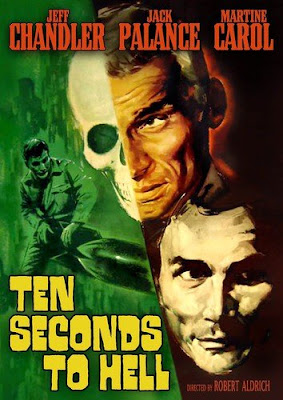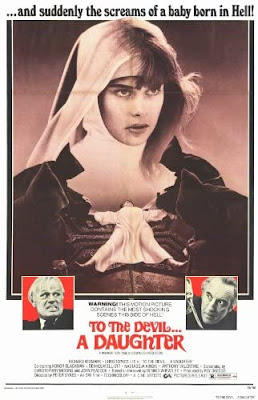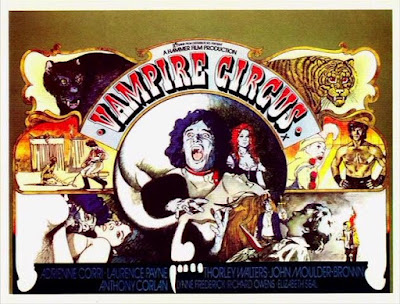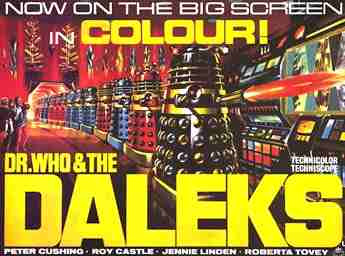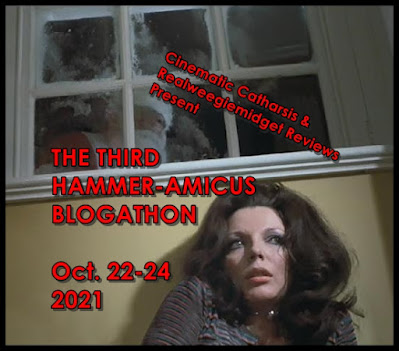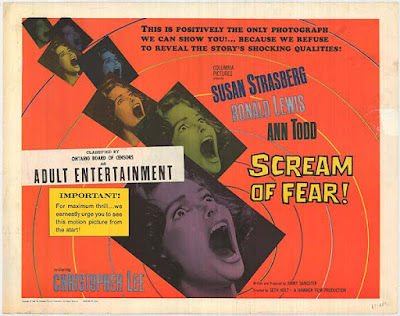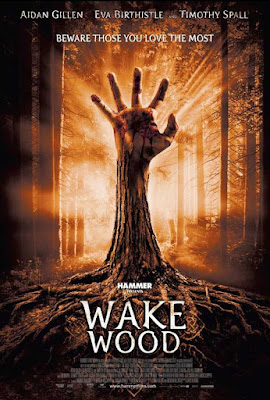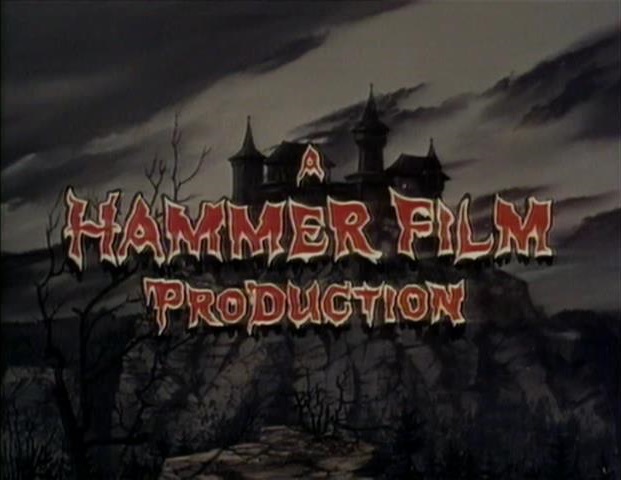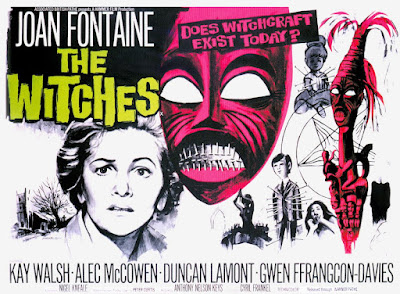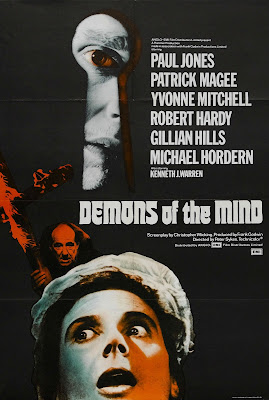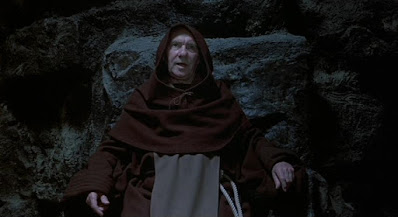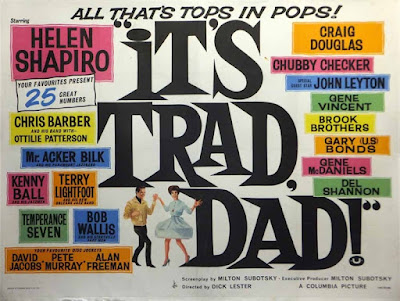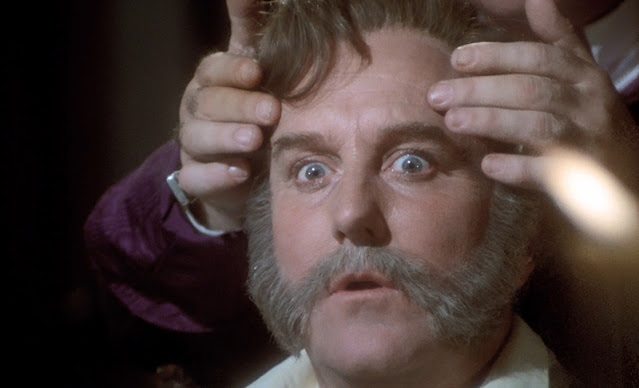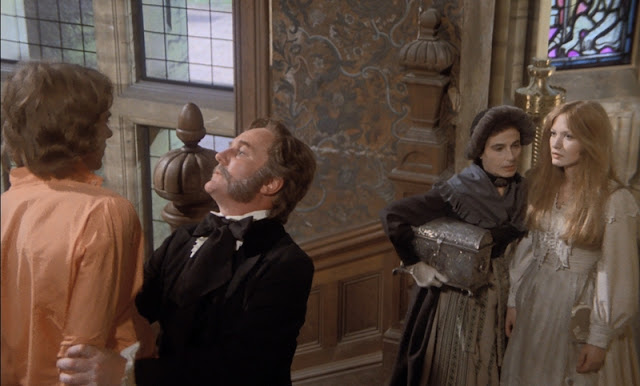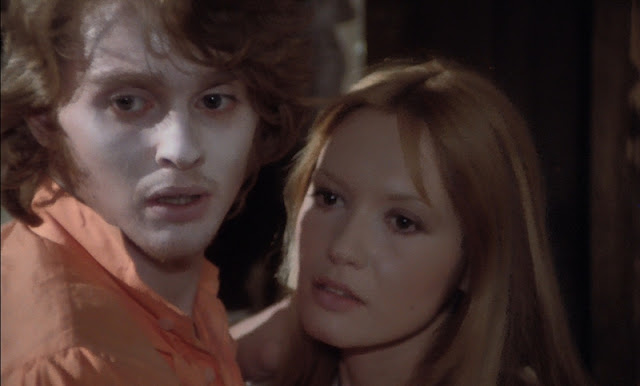Symptoms (1974) Angela Pleasence stars as Helen, a
disturbed young woman in writer/director José Ramón Larraz’s thriller, a bubbling
cauldron of repressed sexuality and unrequited love. She lives alone on a
country estate, nursing the wounds of an unspecified psychological trauma. As a
comfort to her friend in need, Anne (Lorna Heilbron) leaves London to spends
some time with Helen. Over the course of the next several days secrets will be
revealed. Symptoms takes its time, building up suspense
gradually, and letting the story unfold (in the kind of slow-burn approach that’s
so distinctively 1970s). Not much occurs for the first half, but stick with it,
because it’s going to be a bumpy ride. Pleasence turns in a subtly creepy
performance, portraying one woman’s disintegrating psyche.
Rating: ***½. Available on Blu-ray
Parents (1989) What goes on in the secret world of parents when the kids are in bed? Director Bob Balaban’s pitch-dark comedy/horror attempts to answer that question. Balaban and writer Christopher Hawthorne use an idealized ‘50s backdrop to spin a subversive yarn about domestic conformity. A young boy (Bryan Madorsky) suspects his squeaky-clean parents (Randy Quaid and Mary Beth Hurt) are up to something nefarious (Just what is that mystery meat they keep trying to serve him?). The film keeps its cards close to its chest about what his parents are really up to (Are they or aren’t they?) for the first two-thirds. Although Madorsky’s performance tends to be one-note, it’s mainly a foil for all the erratic behavior and skullduggery around him. Even though the climax is a trifle predictable, it’s worth seeing for the build-up.
Rating: ***½. Available on Blu-ray, DVD, Tubi and
Amazon Prime
Grave Encounters (2011) Before you think, “Oh no, not another found footage movie,” give this one a try. The host (Ben Wilkinson) and crew of a TV ghost-hunting series named (Can you guess?), investigate an abandoned mental hospital, which might not be as uninhabited as they originally thought. Although the movie relies on a few too many CGI-enhanced jump scares, it stands out by introducing some intriguing concepts. The more time the investigators spend in the haunted asylum, the further it alters their perception of time and space.
Rating: ***.
Available on Blu-ray, DVD, Shudder, and Amazon Prime
The Terror (1963) If you think Roger Corman’s The Terror seems cobbled together from his other Poe movies, you’re not wrong. Corman repurposed the sets from The Raven for his film, along with a couple of its stars, Boris Karloff as Baron Victor Frederick Von Leppe, and Jack Nicholson, as French soldier, Lt. Andre Duvalier. Corman regulars Jonathan Haze appears as a mute, and Dick Miller (sporting an odd accent) plays the Baron’s butler. Duvalier meets a mysterious young woman wandering the beach (played by Nicholson’s then-wife, Sandra Knight), who seems to be linked to Van Leppe’s castle, and its brooding baron. I’m not sure where the eponymous “Terror” fits in, but Corman’s attempt to (in his words) “out-Poe Poe…” has some nice atmosphere, and Karloff seems game enough. It’s not as bad as some might attest, but there’s a “been there, done that” feel to the production.
Rating: ***. Available on Blu-ray, DVD, Amazon Prime,
and Kanopy
The Gruesome Twosome (1967) Herschell Gordon Lewis does it again, with this gore-laced oddity. An elderly lady (played by Elizabeth Davis, who spouts aphorisms to her stuffed wildcat “Napoleon”) lures young women to her house, under the auspices of having a room for rent. Subsequently, her deranged son Rodney (Chris Martell) scalps them, using their hair for a home-based wig shop (Not exactly a sustainable business model). A snooping college co-ed (Gretchen Wells) investigates a series of missing young women, while her irritating boyfriend doubts her suspicions. The story and characters have about as much depth as a puddle, but if you’re a fan of H.G. Lewis, or just curious about his movies, you could do much worse.
Rating: **½.
Available on DVD
Guru the Mad Monk (1970) Here’s another baffling, bargain-basement wonder from filmmaker extraordinaire, Andy Milligan (I think he had about $50 allotted for this movie, yet somehow managed to stay under budget). Lead Neil Flanagan plays the titular character, a ruthless, self-serving priest who tortures for the thrill of it (a highlight is a scene where he acts against a mirror). He runs his cathedral like a private fiefdom, while sheltering his former mistress, a vampire named Olga (Jaqueline Webb). Everyone recites their lines with a strange cadence as if no one knew what real speech sounded like. The story is supposedly set on an island, but there are no location shots (or stock footage) to establish where they are. Instead, we just hear a looped recording of the crashing of ocean waves and seagulls. Its many faults aside, you have to admire how anyone could attempt to shoot a medieval period piece with virtually no resources, except for the use of an old Manhattan cathedral.
Rating: **½.
Available on DVD and Tubi
The Stone Tape (1972)
The scariest thing in this BBC television production from writer Nigel Kneale
and director Peter Sasdy might be the appalling preponderance of the color
green in the set and costume design, but it does have its moments. The Stone
Tape carries many of the themes that Kneale has explored previously, albeit
with mixed results. The director of an electronics firm (Michael Bryant)
stumbles on a potential new recording medium, thanks to a discovery by his
resident mathematician (Jane Asher). Ghostly sounds and visions emanate from the
ancient stone foundation of an estate, leading a team of researchers to investigate.
Madness and chaos ensue. An interesting premise is hampered by casual racism
and sexism throughout. Overwrought acting, and an unlikable lead also make this
difficult to stomach.
Rating: **½. Available on DVD (Region 2)
The Mummy’s Hand (1940) This sort-of sequel to 1932’s The Mummy is a big step down. An archaeologist (Dick Foran) and his very annoying sidekick (Wallace Ford) set out to find the tomb of Karas, with the promise of untold riches and notoriety. A high priest (George Zucco) who’s sworn to protect the tomb, and the not-so-dead Karas have other plans. There are some impressive sets, and the mummy (played this time by Tom Tyler) is truly frightening. It’s too bad the story is so scattershot and unfocused, and the emphasis on comedy doesn’t help the mood. Watch if you must.
Rating: **½.
Available in The Mummy: Legacy
Collection Blu-ray and DVD













